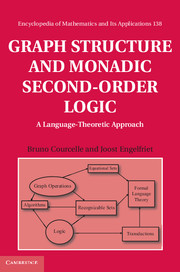Book contents
- Frontmatter
- Contents
- Foreword
- Introduction
- 1 Overview
- 2 Graph algebras and widths of graphs
- 3 Equational and recognizable sets in many-sorted algebras
- 4 Equational and recognizable sets of graphs
- 5 Monadic second-order logic
- 6 Algorithmic applications
- 7 Monadic second-order transductions
- 8 Transductions of terms and words
- 9 Relational structures
- Conclusion and open problems
- References
- Index of notation
- Index
7 - Monadic second-order transductions
Published online by Cambridge University Press: 05 July 2012
- Frontmatter
- Contents
- Foreword
- Introduction
- 1 Overview
- 2 Graph algebras and widths of graphs
- 3 Equational and recognizable sets in many-sorted algebras
- 4 Equational and recognizable sets of graphs
- 5 Monadic second-order logic
- 6 Algorithmic applications
- 7 Monadic second-order transductions
- 8 Transductions of terms and words
- 9 Relational structures
- Conclusion and open problems
- References
- Index of notation
- Index
Summary
Monadic second-order transductions are transformations of relational structures specified by monadic second-order formulas. They can be used to represent transformations of graphs and related combinatorial structures via appropriate representations of these objects by relational structures, as shown in the examples discussed in Section 1.7.1.
These transductions are important for several reasons. First, because they are useful tools for constructing monadic second-order formulas with the help of the Backwards Translation Theorem (Theorem 7.10). Second, because by means of the Equationality Theorems (Theorems 7.36 and 7.51) they yield logical characterizations of the HR- and VR-equational sets of graphs that are independent of the signatures FHR and FVR. From these characterizations, we get short proofs that certain sets of graphs have bounded, or unbounded, tree-width or clique-width.
They also play the role of transducers in formal language theory: the image of a VR-equational set of graphs under a monadic second-order transduction is VR-equational, and a similar result holds for HR-equational sets and monadic second-order transductions that transform incidence graphs. Finally, the decidability of the monadic second-order satisfiability problem for a set of structures C implies the decidability of the same problem for its image τ(C) under a monadic second-order transduction τ. Hence, monadic second-order transductions make it possible to relate decidability and undecidability results concerning monadic second-order satisfiability problems for graphs and relational structures.
Section 7.1 presents the definitions and the fundamental properties. Section 7.2 is devoted to the Equationality Theorem for the VR algebra, one of the main results of this book.
- Type
- Chapter
- Information
- Graph Structure and Monadic Second-Order LogicA Language-Theoretic Approach, pp. 505 - 577Publisher: Cambridge University PressPrint publication year: 2012



